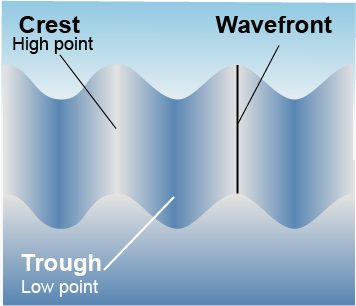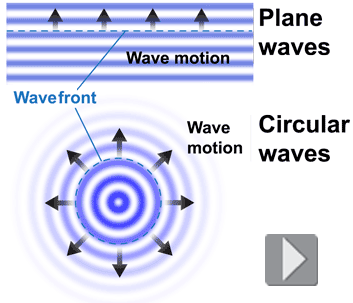|
The word propagate means to spread out and grow. Waves propagate outward from their source, carrying both energy and information. The direction and speed at which a wave propagates depend on many factors, such as the shape of the wave and the medium through which the wave moves. 
|
How waves propagate
|
Sound and water waves propagate through matter because of connections. Any disturbance in one place causes a disturbance in the matter immediately adjacent, which disturbs the matter adjacent to that, and so on. Consider a stone falling into water. Some water is pushed aside where the stone crosses the surface (left). The higher water pushes the water next to it out of the way as it tries to flow back down to equilibrium (center). The water that has been pushed then pushes on the water in front of it, and so on. The wave spreads through the interaction of each bit of water with the water immediately next to it (right). 
|

|
 Water waves propagate in two dimensions along a surface. Think of the expanding circular ripples spreading out on the water from the drop of a stone. Each circle represents a crest or trough of the expanding wave. A crest represents all the high points of one cycle. A trough represents all the low points. We often draw the crests on diagrams to show how a wave moves. The crest is sometimes called a wavefront. A wavefront describes the two- or three-dimensional shape of the crest of a wave.
Water waves propagate in two dimensions along a surface. Think of the expanding circular ripples spreading out on the water from the drop of a stone. Each circle represents a crest or trough of the expanding wave. A crest represents all the high points of one cycle. A trough represents all the low points. We often draw the crests on diagrams to show how a wave moves. The crest is sometimes called a wavefront. A wavefront describes the two- or three-dimensional shape of the crest of a wave. 
|
 Waves always move perpendicular to their wavefronts. This is easiest to see with circular waves and plane waves. The wavefronts of a plane wave are straight lines and the wavefronts move perpendicular to the lines. The wavefronts of a circular wave are circles and the wave moves radially outward from the center. At each point on the circle the wave expands in the direction perpendicular to the wavefront. This property of waves is very important to technology. If you want to control the direction of a wave, then you do it by changing the shape of its wavefront.
Waves always move perpendicular to their wavefronts. This is easiest to see with circular waves and plane waves. The wavefronts of a plane wave are straight lines and the wavefronts move perpendicular to the lines. The wavefronts of a circular wave are circles and the wave moves radially outward from the center. At each point on the circle the wave expands in the direction perpendicular to the wavefront. This property of waves is very important to technology. If you want to control the direction of a wave, then you do it by changing the shape of its wavefront. 
|
How is amplitude related to the difference between the heights of the crests and troughs?
 |
The amplitude is half the difference between the heights of the crest and the trough. 
|

